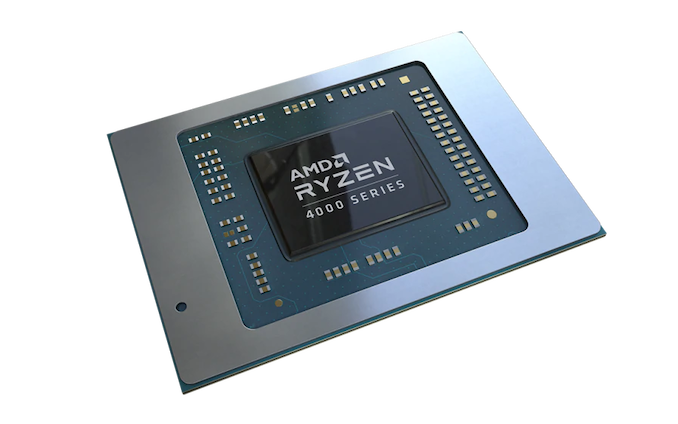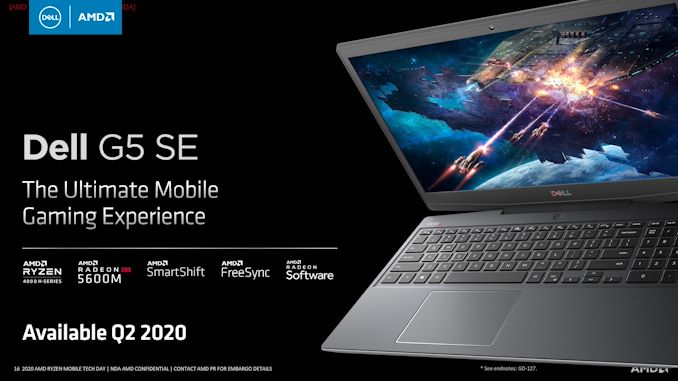AMD Confirms That SmartShift Tech Only Shipping in One Laptop For 2020
by Ryan Smith on June 5, 2020 5:00 PM EST
Launched earlier this year, AMD’s Ryzen 4000 “Renoir” APUs brought several new features and technologies to the table for AMD. Along with numerous changes to improve the APU’s power efficiency and reduce overall idle power usage, AMD also added an interesting TDP management feature that they call SmartShift. Designed for use in systems containing both an AMD APU and an AMD discrete GPU, SmartShift allows for the TDP budgets of the two processors to be shared and dynamically reallocated, depending on the needs of the workload.
As SmartShift is a platform-level feature that relies upon several aspects of a system, from processor choice to the layout of the cooling system, it is a feature that OEMs have to specifically plan for and build into their designs. Meaning that even if a laptop uses all AMD processors, it doesn’t guarantee that the laptop has the means to support SmartShift. As a result, only a single laptop has been released so far with SmartShift support, and that’s Dell’s G5 15 SE gaming laptop.
Now, as it turns out, Dell’s laptop will be the only laptop released this year with SmartShift support.
In a comment posted on Twitter and relating to an interview given to PCWorld’s The Full Nerd podcast, AMD’s Chief Architect of Gaming Solutions (and Dell alumni) Frank Azor has confirmed that the G5 15 SE is the only laptop set to be released this year with SmartShift support. According to the gaming frontman, the roughly year-long development cycle for laptops combined with SmartShift’s technical requirements meant that vendors needed to plan for SmartShift support early-on. And Dell, in turn, ended up being the first OEM to jump on the technology, leading to them being the first laptop vendor to release a SmartShift-enabled laptop.
It's a brand new technology and to @dell credit they jumped on it first. I explained reasons why during my interview with @pcworld @Gordonung @BradChacos No more SmartShift laptops are coming this year but the team is working hard on having more options ASAP for 2021.
— Frank Azor (@AzorFrank) June 4, 2020
Azor’s comment further goes on to confirm that AMD is working to get more SmartShift-enabled laptops on the market in 2021; there just won’t be any additional laptops this year. Which leaves us in an interesting situation where, Dell, normally one of AMD's more elusive partners, has what's essentially a de facto exclusive on the tech for 2020.
Source: Twitter












54 Comments
View All Comments
Cooe - Friday, June 5, 2020 - link
The 5700M is a good piece of silicon, but nobody wants to use it. The 5600M isn't bad either (it's basically a cheaper GTX 1660 Ti). The RX 5500M is trash though, no doubt.senttoschool - Saturday, June 6, 2020 - link
This is correct. I want an AMD APU + an Nvidia 3xxx GPU in my next laptop.I want ray tracing + DLSS 2.0 + Cuda cores for machine learning.
Spunjji - Monday, June 8, 2020 - link
They're fine. Not brilliant, but they would definitely add a lot to the competitive marketplace if someone would use the damned things.yeeeeman - Saturday, June 6, 2020 - link
Aaand the only single product is made by the most Intel loving company in the world.linababe - Saturday, June 6, 2020 - link
is there any chance of smartshift appearing in any of the am4 apus?Ryan Smith - Saturday, June 6, 2020 - link
SmartShift is based around the idea of a shared TDP budget and shared cooling system. With the notable exception of open loop liquid cooling, desktops don't have shared CPU/GPU coolers. Nor are they so heavily cooling-constrained like laptops are.IntelUser2000 - Saturday, June 6, 2020 - link
Laptops have different requirements than building desktops, and system builders have a different goal than component vendors such as AMD/Intel.Even in Intel laptops power states are not fully implemented or taken full advantage of. Especially since it increases TTM(time-to-market) they often have to sacrifice few things to get it working.
brucethemoose - Saturday, June 6, 2020 - link
Well, from what I've seen, AMD's Navi laptop GPUs aren't as power efficient as Turing. Which is... suprising, given the large process advantage. So why would OEMs want to use them?This feature would make more sense if AMD sold big, underclocked 5700 XTs akin to Nvidia's MaxQ GPUs.
Spunjji - Monday, June 8, 2020 - link
"This feature would make more sense if AMD sold big, underclocked 5700 XTs"That's exactly what the 5700M is. Nobody's integrating it, though.
I guess we'll have to wait for RDNA2, at which point people will probably be saying that no OEM is using it because none of them used RDNA... etc.
CiccioB - Monday, June 8, 2020 - link
That rises the power efficiency without doubts but then you have always to compare that solution with what provides the competition.Nvidia offers 2080Max-Q@80W. What is going to obtain AMD with 80W? They would probably need a 1000mm^2 GPU to be as efficient as the TU104.